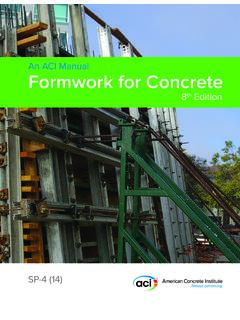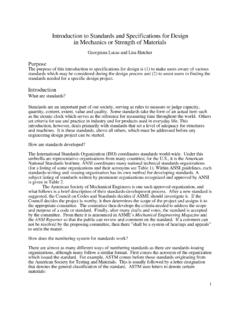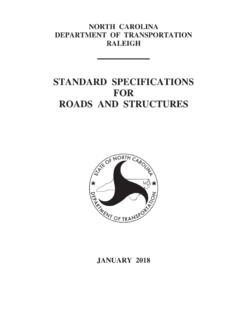Transcription of Measured Load Capacity of Buried Reinforced Concrete Pipes
1 ACI structural JOURNAL TECHNICAL PAPER. Title No. 113-S06. Measured Load Capacity of Buried Reinforced Concrete Pipes by Katrina MacDougall, Neil A. Hoult, and Ian D. Moore Reinforced Concrete Pipes in North America are often designed bearing to their performance in place. A limited amount using the Indirect Design Method, which uses bedding factors of testing has been conducted on Buried Pipes to evaluate to relate in-place pipe performance to the performance obtained whether these bedding factors are appropriate. To address from three-edge bearing tests.
2 The key performance indicator is this knowledge gap, a series of Buried Reinforced Concrete the load at which the mm ( in.) critical crack is devel- pipe experiments was undertaken at both shallow burial oped. The current bedding factors were developed using numer- under surface loading and simulated deep burial to evaluate ical modeling, and a limited amount of experimental verification has been performed to determine the accuracy of the approach. As the pipe performance. These results were then combined such, a series of shallow burial tests with surface loading, a simu- with three-edge bearing test results to evaluate the appropri- lated deep burial test, and three-edge bearing tests were under- ateness of the bedding factors.
3 Taken on and m (24 and 48 in.) diameter Pipes to evaluate the current bedding factors. Both the shallow and deep burial tests BACKGROUND. indicated that the critical crack does not develop until after the There has been limited full-scale Buried pipe testing specified service load has been surpassed, suggesting that current performed to assess the effect of surface loading on rein- pipe designs are overly conservative. forced Concrete Pipes . Testing performed by Wong et al. (2006) used pressure sensors installed on small-diameter Keywords: Buried pipe; crack widths; Indirect Design Method; Reinforced Concrete .
4 (less than m [36 in.]) Reinforced Concrete Pipes Buried in the field in areas under high traffic loading. When the pres- INTRODUCTION sure sensor results were compared to the Indirect Design The AASHTO (2013) LRFD Bridge Design Code speci- estimates, it was found that the equations resulted in overly fies two methods for the design of Reinforced Concrete pipe: conservative soil stresses. Indirect Design and Direct Design. The Indirect Design Becerril Garc a and Moore (2013) (also refer to Moore et al. Method attempts to relate the critical load obtained during [2012]) performed surface load tests on Buried and m three-edge bearing tests conducted by the pipe manufac- (24 and 48 in.)
5 Diameter Pipes . Although the work focused turer (ASTM C497-13) to the Capacity of the Pipes in-place on the structural response of pipe joints, the particular test through a modification factor known as the bedding factor. Pipes were consistently found to be able to carry service The critical load is specified as the load at which a mm loads without cracking, which is the critical limit state of the ( in.) crack forms inside the pipe. However, there has Indirect Design Method. been limited experimental testing undertaken to determine Field tests were performed by Erdogmus and Tadros whether the bedding factors are appropriate, as they are (2009) on m (48 in.)
6 Diameter pipe with a wall thick- based on the results of numerical analysis (McGrath 1993). ness of 127 mm (5 in.) under varying depths of embank- To address this knowledge gap in Reinforced Concrete ment earth loading. Additionally, these same Pipes were pipe design, a research program was undertaken with the tested in three-edge bearing. In the Buried test, strain gauges following objectives: 1) to measure the diameter changes, on the reinforcement cage at the crown, invert, springline, strains, and crack widths that develop in the pipe wall for haunch, and shoulder (the critical locations around the pipe shallow burial under surface loads and under simulated deep circumference are illustrated in Fig.
7 1) were used to monitor burial loading; 2) to conduct ultimate limit state tests on the the development of strain in the reinforcement under earth Buried Pipes to determine the load at which the critical crack loads. Erdogmus and Tadros found the test pipe resisted a width develops; 3) to obtain three-edge bearing test data to 50-D (Class II-equivalent) D-Load in the three-edge bearing support the Indirect Design calculations; and 4) to compare test, which corresponds to a maximum cover depth of these results to Indirect Design estimates. 3 m (10 ft).
8 However, under Buried conditions the pipe steel The paper outlines previous research, the experimental reinforcement had not even reached yielding at 6 m (20 ft). program, the pipe specimens, the instrumentation, and the of cover. These results show that the relationship between test setup for the full-scale tests on the Buried Reinforced three-edge bearing performance and Buried conditions may Concrete pipe specimens. The results of the testing program not be accurately captured by the current bedding factors;. are then presented and discussed. RESEARCH SIGNIFICANCE ACI structural Journal, V.
9 113, No. 1, January-February 2016. MS No. , doi: , received April 15, 2015, and Reinforced Concrete Pipes are often designed using the reviewed under Institute publication policies. Copyright 2016, American Concrete Institute. All rights reserved, including the making of copies unless permission is Indirect Design Method, which employs bedding factors obtained from the copyright proprietors. Pertinent discussion including author's to correlate the performance of Pipes tested in three-edge closure, if any, will be published ten months from this journal's date if the discussion is received within four months of the paper's print publication.
10 ACI structural Journal/January-February 2016 63. Table 1 Test program overview Test program Facility Diameter, m Diameter, in. Loading type Depths, ft Depth, m A West test pit 24 Earth and simulated vehicle 1, 2, and 4 , , and A West test pit 48 Earth and simulated vehicle 1, 2, and 4 , , and B Biaxial cell 24 Earth load (deep burial) 1 to 152 *. to *. C Load frame 48 Three-edge bearing Unburied Unburied *. Equivalent depth of burial for soil of density of kN/m (130 lb/ft ). 3 3. Table 2 Pipe specimen properties Area of steel, mm2/m ( ). Pipe inner Wall Wall thickness, Class fc , MPa fy, MPa fu, MPa Wire gauge, Spacing, diameter, mm type mm (in.)



